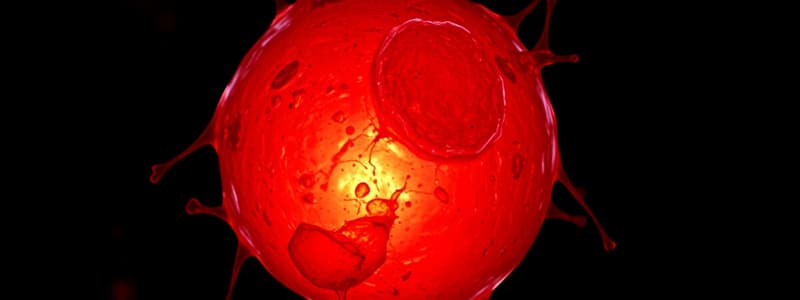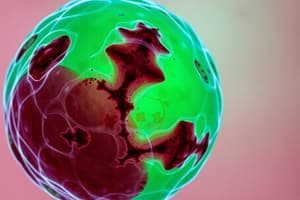Podcast
Questions and Answers
What characterizes dystrophic calcification?
What characterizes dystrophic calcification?
- Always causes significant organ impairment.
- Is primarily related to increased calcium levels in the blood.
- Is associated with normal serum levels of calcium. (correct)
- Occurs in living tissues affected by metabolic derangement.
Which of the following conditions can lead to hypercalcæmia?
Which of the following conditions can lead to hypercalcæmia?
- Chronic dehydration.
- Hypoparathyroidism.
- Chronic liver disease.
- Primary hyperparathyroidism. (correct)
What is the primary difference between atrophy and hypertrophy?
What is the primary difference between atrophy and hypertrophy?
- Atrophy leads to an increase in cell size, while hypertrophy decreases it.
- Hypertrophy is a response to decreased workload, while atrophy occurs during increased function.
- Atrophy involves shrinkage in cell size, whereas hypertrophy involves an increase in cell size. (correct)
- Both atrophy and hypertrophy result in the same cellular function.
In metastatic calcification, which statement is correct?
In metastatic calcification, which statement is correct?
What is a common cause of atrophy in cells?
What is a common cause of atrophy in cells?
What is a key characteristic of necrosis?
What is a key characteristic of necrosis?
Which of the following best distinguishes hypoxia from ischemia?
Which of the following best distinguishes hypoxia from ischemia?
Which intracellular system is particularly vulnerable to injury?
Which intracellular system is particularly vulnerable to injury?
How does aging contribute to cell injury?
How does aging contribute to cell injury?
What type of injury involves adaptive capability being exceeded?
What type of injury involves adaptive capability being exceeded?
Which of the following is a physical agent that can cause cell injury?
Which of the following is a physical agent that can cause cell injury?
What role do chemicals and drugs play in cell injury?
What role do chemicals and drugs play in cell injury?
Which aspect does not contribute to the severity of cell injury?
Which aspect does not contribute to the severity of cell injury?
What does cytoplasmic eosinophilia indicate?
What does cytoplasmic eosinophilia indicate?
What type of necrosis is characterized by preservation of cellular outlines for days?
What type of necrosis is characterized by preservation of cellular outlines for days?
Which of the following is a morphological change seen in necrosis?
Which of the following is a morphological change seen in necrosis?
Which type of necrosis is commonly associated with tuberculosis?
Which type of necrosis is commonly associated with tuberculosis?
What cellular change leads to a glassy appearance in necrotic cells?
What cellular change leads to a glassy appearance in necrotic cells?
Which process is responsible for the enzymatic digestion in necrosis?
Which process is responsible for the enzymatic digestion in necrosis?
What is a key feature of liquefactive necrosis?
What is a key feature of liquefactive necrosis?
Which of the following is NOT a nuclear alteration observed in necrosis?
Which of the following is NOT a nuclear alteration observed in necrosis?
Which factor is NOT associated with fatty change in tissues?
Which factor is NOT associated with fatty change in tissues?
What distinguishes gangrenous necrosis from other types of necrosis?
What distinguishes gangrenous necrosis from other types of necrosis?
What is the initial effect of hypoxia on cellular respiration?
What is the initial effect of hypoxia on cellular respiration?
What results from the influx of extracellular calcium during ischæmic injury?
What results from the influx of extracellular calcium during ischæmic injury?
Which of the following is a characteristic of irreversible injury?
Which of the following is a characteristic of irreversible injury?
What is the role of mitochondrial calcium release during cellular injury?
What is the role of mitochondrial calcium release during cellular injury?
What occurs as a result of the accumulation of lactic acid during hypoxia?
What occurs as a result of the accumulation of lactic acid during hypoxia?
What happens during reperfusion of an ischæmic area?
What happens during reperfusion of an ischæmic area?
Which process occurs when ribosomes detach from the rough endoplasmic reticulum during hypoxia?
Which process occurs when ribosomes detach from the rough endoplasmic reticulum during hypoxia?
What is indicated by cytoplasmic eosinophilia under light microscopy?
What is indicated by cytoplasmic eosinophilia under light microscopy?
Which factor contributes to cell death during ischæmic injury?
Which factor contributes to cell death during ischæmic injury?
What is the primary result of decreased ATP and AMP levels during cellular injury?
What is the primary result of decreased ATP and AMP levels during cellular injury?
What is the primary trigger for apoptosis in cells?
What is the primary trigger for apoptosis in cells?
What characterizes fat necrosis in the context of acute pancreatitis?
What characterizes fat necrosis in the context of acute pancreatitis?
Which of the following statements about apoptosis is incorrect?
Which of the following statements about apoptosis is incorrect?
Which of the following can occur due to intracellular accumulation?
Which of the following can occur due to intracellular accumulation?
What is the consequence of protease activation during apoptosis?
What is the consequence of protease activation during apoptosis?
Which type of apoptosis is responsible for cell deletion in the thymus?
Which type of apoptosis is responsible for cell deletion in the thymus?
What appearance do apoptotic cells typically have under H&E staining?
What appearance do apoptotic cells typically have under H&E staining?
Which of the following describes a characteristic of storage diseases?
Which of the following describes a characteristic of storage diseases?
What happens during karyorrhexis in apoptosis?
What happens during karyorrhexis in apoptosis?
What might cause intracellular accumulation in normal cells?
What might cause intracellular accumulation in normal cells?
Flashcards are hidden until you start studying
Study Notes
Cell Injury
- Cells maintain a narrow range of physiological activities within their intracellular milieu
- Cell injury occurs when the adaptive capability of a cell is exceeded
- There are two principal patterns of cell death: necrosis and apoptosis
- Necrosis occurs after exposure to noxious conditions and is characterized by cell swelling, protein denaturation and organellar breakdown
- Apoptosis is programmed cell death occurring in normal or physiological conditions
Causes Of Cell Injury
- Hypoxia: Impedes aerobic oxidative respiration; should be distinguished from ischemia, which also results in hypoxic cell injury
- Physical agents: Trauma, temperature extremes, radiation, electric shock, sudden atmospheric pressure changes
- Chemicals and drugs: May alter membrane permeability, osmotic homeostasis, or enzyme cofactor integrity
- Microbiologic agents: Range from viruses to tapeworms
- Immunologic reactions: Body's immune system can cause cell injury, e.g., anaphylactic reaction
- Genetic defects: E.g., Down syndrome, sickle cell anemia
- Nutritional imbalances: Protein-calorie insufficiency, vitamin deficiencies; diets rich in animal fat are implicated in atherosclerosis pathogenesis
- Aging:
Mechanisms Of Cell Injury
- Cell response to injuries depends on the type of injury, duration, and severity
- Consequences of injury depend on the type of cell, current health status, and adaptability
- Four intracellular systems are vulnerable to injury:
- Cell membrane integrity (altering ionic and osmotic homeostasis)
- Aerobic respiration
- Protein synthesis
- Genetic apparatus
- Calcium influx:
- Cytosolic free calcium is maintained at low levels by ATP-dependent calcium transporters
- Ischemia or toxins allow calcium influx from the extracellular space, with mitochondrial calcium release
- Activates enzymes like phospholipases, proteases, ATPases, and endonucleases
- Oxygen free radicals: Important mediators of cell death
Ischemic And Hypoxic Injury
- Reversible Injury:
- First effect of hypoxia is on aerobic respiration, reducing intracellular ATP
- Reduced ATP leads to:
- Influx of extracellular calcium
- Reduced plasma membrane sodium pump activity
- Intracellular sodium accumulation
- Potassium diffusion out of the cell
- Isosmotic water gain, resulting in acute cellular swelling
- Accumulation of metabolites: inorganic phosphates, lactic acid, purine nucleotides
- Increased anaerobic glycolysis due to decreased ATP and AMP, leading to glycogen depletion, lactic acid and inorganic phosphate accumulation, and reduced intracellular pH
- Detachment of ribosomes from the endoplasmic reticulum, reducing protein synthesis
- If hypoxia continues, the cytoskeleton disappears, resulting in loss of ultrastructural features (microvilli) and cell surface blebs
- Irreversible Injury:
- Severe vacuolization of mitochondria and calcium particle accumulation
- Extensive plasma membrane damage
- Swelling of lysosomes
- Calcium-mediated injury upon reperfusion of oxygen
- Continued loss of proteins, coenzymes, and RNA from hyperpermeable membranes
- Leakage of lysosomal enzymes into the cytoplasm, degrading cytoplasmic components
- Dead cells may be replaced by whorled masses of phospholipids (myelin figures)
Mechanisms Of Irreversible Injury
- Progressive loss of membrane phospholipids
- Cytoskeletal abnormalities: Protease activation and increased calcium can detach the cell membrane
- Toxic oxygen radicals: Generated after reperfusion of the ischemic area, released by neutrophils
- Lipid breakdown products: Have detergent effects
Cellular Accumulations
- Cells may accumulate abnormal substances transiently or permanently, harmful or injurious, located in the cytoplasm or nucleus
- Substances may be synthesized by the cell or produced elsewhere
- Accumulations categorized into three types:
- Normal endogenous substance produced at normal or increased rate, with inadequate metabolism (e.g., fatty change of the liver)
- Normal or abnormal endogenous substance that can't be metabolized due to genetic enzymatic defect (storage diseases)
- Deposition in dead or dying tissues (dystrophic calcification)
Dystrophic Calcification
- Deposition occurs despite normal serum calcium levels and absence of calcium metabolic derangement
- Encountered in areas of necrosis, seen in atheromas of advanced atherosclerosis, intimal injuries of large arteries, aging, aortic valves
- Appears as intracellular or extracellular basophilic deposits; sometimes heterotopic bone may be formed
Metastatic Calcification
- Occurs in normal tissues when hypercalcemia exists
- Causes of hypercalcemia include:
- Primary endocrine dysfunction (hyperparathyroidism)
- Tumors associated with increased bone catabolism (multiple myeloma, metastatic cancer, leukemia)
- Ingested exogenous substances causing vitamin D intoxication or milk alkali syndrome
- Sarcoidosis
- Advanced renal failure (secondary hyperparathyroidism due to phosphate retention)
- Metastatic calcification may occur widely in tissues, primarily in the interstitial tissues, kidneys, lungs, and gastric mucosa
- Usually does not significantly impair organ function, but extensive nephrocalcinosis can cause impairment
Cellular Adaptations Of Growth And Differentiation
- Physiologic adaptations are responses to normal stimulation by hormones or endogenous chemicals (e.g., breast growth and lactation)
- Pathologic adaptations often share the same underlying mechanisms, allowing cells to modulate their environment and avoid injury
Atrophy
- Shrinkage in cell size due to loss of cell substance; may involve the entire organ
- Atrophied cells have diminished function but are not dead
- Apoptotic death can be induced by the same signals causing atrophy
- Causes:
- Decreased workload
- Loss of innervation
- Diminished blood supply
- Inadequate nutrition
- Loss of endocrine stimulation
- Aging
- Cells become smaller, reaching an equilibrium with reduced blood supply, nutrition, or trophic stimulation
- Biochemically: Decreased synthesis, increased catabolism, or both
Hypertrophy
- Increase in cell size due to increased synthesis of structural proteins and organelles, resulting in an enlarged organ
- Examples:
- Increased muscle mass due to exercise (physiological hypertrophy)
- Enlargement of the heart in hypertension (pathological hypertrophy)
Studying That Suits You
Use AI to generate personalized quizzes and flashcards to suit your learning preferences.




